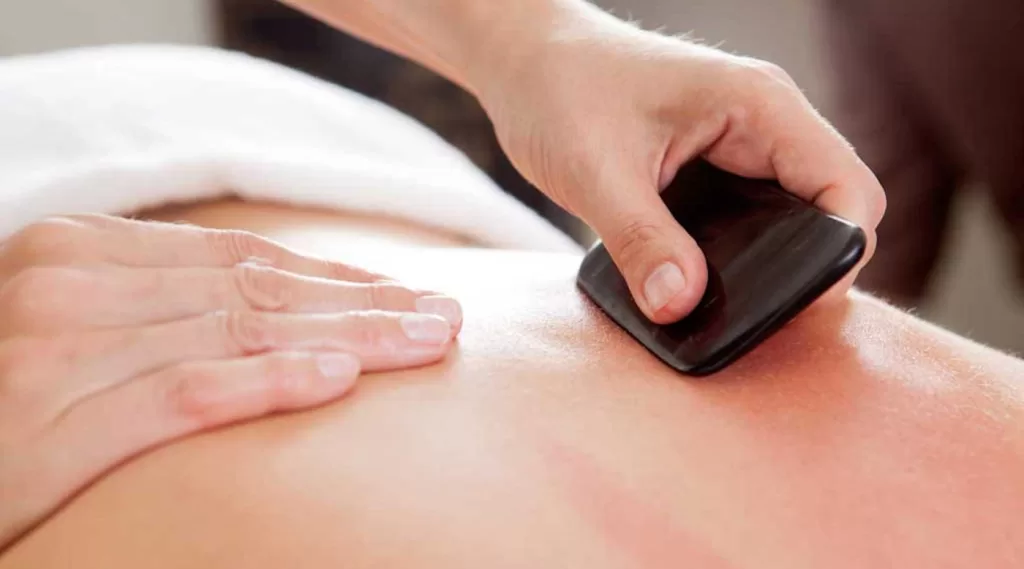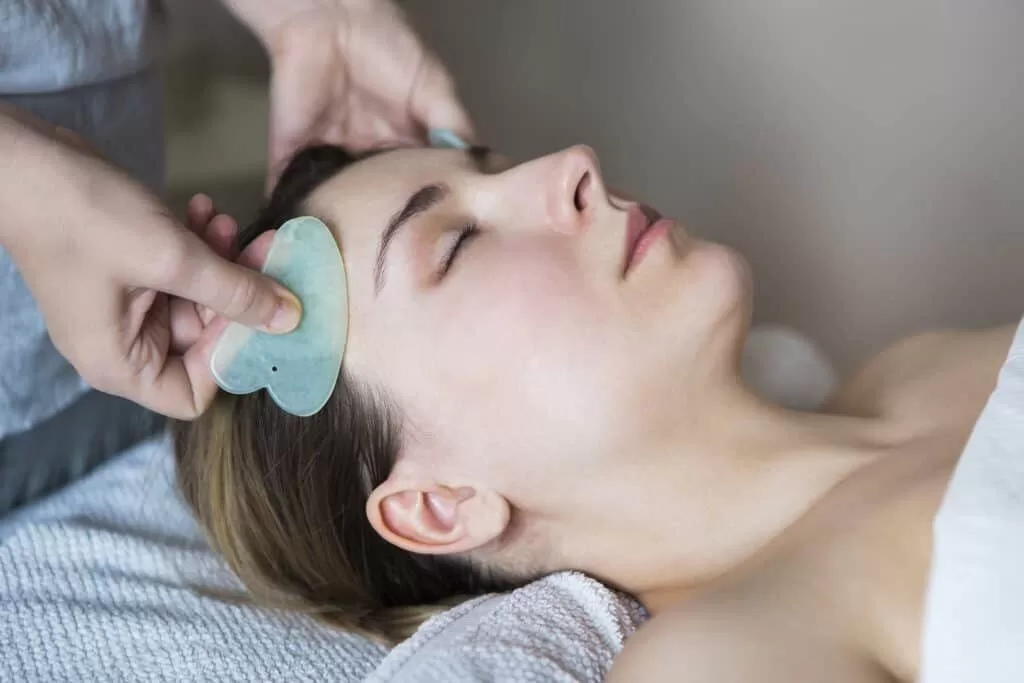
Gua sha for health life is truth? Yes, gua sha therapy, also known as Gua Sha, can offer several health benefits. While it is often praised for its natural beauty effects, its primary and fundamental function lies in its role as a traditional Chinese medicine treatment. In this article, we will explore how Gua Sha can be employed to alleviate symptoms associated with headaches.
Before engaging in Gua Sha, it is essential to understand the causes of your headaches. If the headache is a result of external trauma, Guasha may not address your issue. It is most effective for headaches caused by blockages in meridians or muscle tension due to constriction.
1. Causes of Head Pain:
- Prolonged sitting in a position with the head lowered and the body bent can cause tension in the neck, cervical vertebrae, and trapezius muscle. Over time, this can lead to soreness in the shoulders and neck, extending to the head, resulting in pain in all three areas simultaneously.
- Headaches caused by meridian blockages due to a cold, leading to throbbing pain in the head.
- Lack of exercise or poor diet and lifestyle habits can gradually lead to meridian blockages, ultimately causing headaches.
- Tension and stress: Prolonged periods of tension and high-stress levels can result in headaches, especially in the neck and shoulders.
- Eye fatigue: Prolonged staring at computer screens, phones, or books may cause eye fatigue, triggering headaches.
- Poor posture: Incorrect sitting or sleeping positions, especially maintained for extended periods, can cause tension in the muscles of the neck and head, leading to headaches.
- Lack of sleep: Insufficient sleep can result in body fatigue and tension, leading to headaches.
- Dietary factors: Certain components in the diet, such as caffeine, tyramine, nitrites, etc., may sometimes cause headaches.
- Overuse of medications: Long-term or excessive use of certain drugs, especially painkillers, may lead to medication-overuse headaches.
- Climate changes: Weather fluctuations, temperature changes, humidity variations, etc., can trigger headaches.
- Dehydration: Dehydration may increase blood viscosity, affecting blood circulation in the brain and causing headaches.
- Neck problems: Issues or injuries in the cervical vertebrae may lead to headaches, especially tension-type headaches.
- Vision problems: Uncorrected vision issues can cause eye strain, resulting in headaches.
- Hormonal changes: Women may experience headaches during menstrual cycles, pregnancy, menopause, etc., due to hormonal fluctuations.
Out of the fourteen mentioned reasons, Gua Sha may not be effective for improving conditions related to 8, 9, 10, 11, and 14.
Gua Sha for Health Life – How to Use Gua Sha fo Headache?
Gua Sha is a traditional Chinese medical therapy that typically involves using special gua sha tools to apply pressure to the skin, promoting blood circulation, relieving muscle tension, and enhancing the body’s natural healing abilities. Below are some steps and precautions to help alleviate headache symptoms through Gua Sha:
1. Materials and Tools:
Gua Sha board or tool: These tools are often made of various materials such as buffalo horn, jade, agate, etc.
Massage oil or Gua Sha oil: Used to reduce skin friction and prevent excessive irritation.
2. Steps:
- Prepare Tools and Environment: Before starting Gua Sha, ensure your tools are clean, and perform the therapy in a quiet, comfortable environment.
- Prepare the Skin: Apply some massage oil to the areas where Gua Sha will be performed to reduce friction and help the tool glide smoothly on the skin.
- Select the Gua Sha Areas: For headaches, focus on the areas around the neck, shoulders, and head. Gua Sha in these areas may help relieve muscle tension associated with headaches.
- Gentle gua sha: Start gua shagently, gradually increasing pressure. Use the Gua Sha tool to apply sustained pressure at a moderate pace on the targeted areas.
- gua shaDirection: The direction of gua sha is typically along the lymphatic flow, which can be downward or outward. Avoid gua sha in the opposite direction to prevent excessive skin stimulation.
- Repeat: You can repeat the Gua Sha process, but avoid overdoing it to prevent excessive stimulation.
- Monitor Reaction: Pay attention to the body’s response during Gua Sha. If discomfort or pain occurs, stop the therapy.
- Post-Gua Sha Care: After Gua Sha, you can use hot or cold compresses to further alleviate symptoms, depending on personal comfort.
Precautions:
- Gua Sha should be gentle and not too forceful or frequent.
- Avoid Gua Sha on areas with wounds, rashes, or other skin conditions.
- If there are any illnesses or health issues, it’s advisable to consult a doctor before Gua Sha.
- While Gua Sha may be beneficial for some, it may not be suitable for everyone or every situation. Before using Gua Sha or any other alternative therapy, it’s recommended to seek advice from a doctor, especially if there are underlying health issues or symptoms.
From a Traditional Chinese Medicine Perspective, How Can We Try to Avoid Headaches?
Although it’s helpful about gua sha for health life, we should nip it in the bud.
From a Chinese medicine perspective, headaches are often related to factors such as impaired blood and Qi circulation, dysfunction of organs, and invasion of wind, cold, or dampness. Here are some Chinese medicine suggestions to help avoid behaviors that could lead to headaches:
- Maintain Emotional Balance: Fluctuating emotions, stress, and tension can hinder Qi and blood circulation, triggering headaches. Maintain emotional balance through activities like exercise, meditation, and deep breathing.
- Good Sleep Habits: Regular sleep patterns contribute to balanced organ function. Strive for consistent wake-up and bedtime hours to help regulate the body’s internal clock.
- Avoid Excessive Fatigue: Prolonged work or study sessions can lead to muscle tension, especially in the neck and shoulders, resulting in headaches. Adequate rest and moderate exercise can alleviate muscle tension.
- Dietary Adjustments: Avoid overeating, excessive alcohol consumption, and the intake of spicy, irritating foods. Maintain a balanced and light diet to support the balance of spleen and stomach functions.
- Eye Protection: Extended periods of staring at computers, phones, or books can cause eye fatigue and subsequently lead to headaches. Take regular breaks for your eyes and maintain good eye habits.
- Avoid Cold and Dampness: Chinese medicine attributes wind, cold, and dampness as common factors causing headaches. Stay warm in cold and damp environments to prevent exposure.
- Prevent Wind Invasion: When outdoors, pay attention to keeping warm and avoid direct exposure to the wind. Wear a hat, especially in cold seasons.
- Regular Therapies: Periodic Chinese medicine therapies such as massage, cupping, and moxibustion can help promote Qi and blood circulation, adjusting organ function.
- Prevent Eye Strain: Prolonged eye use can lead to eye fatigue, causing headaches. Regularly rest your eyes and engage in eye exercises for eye care.
- Maintain Good Posture: Avoid prolonged maintenance of the same posture, especially for the head and neck. Correct sitting and standing postures help reduce the burden.


